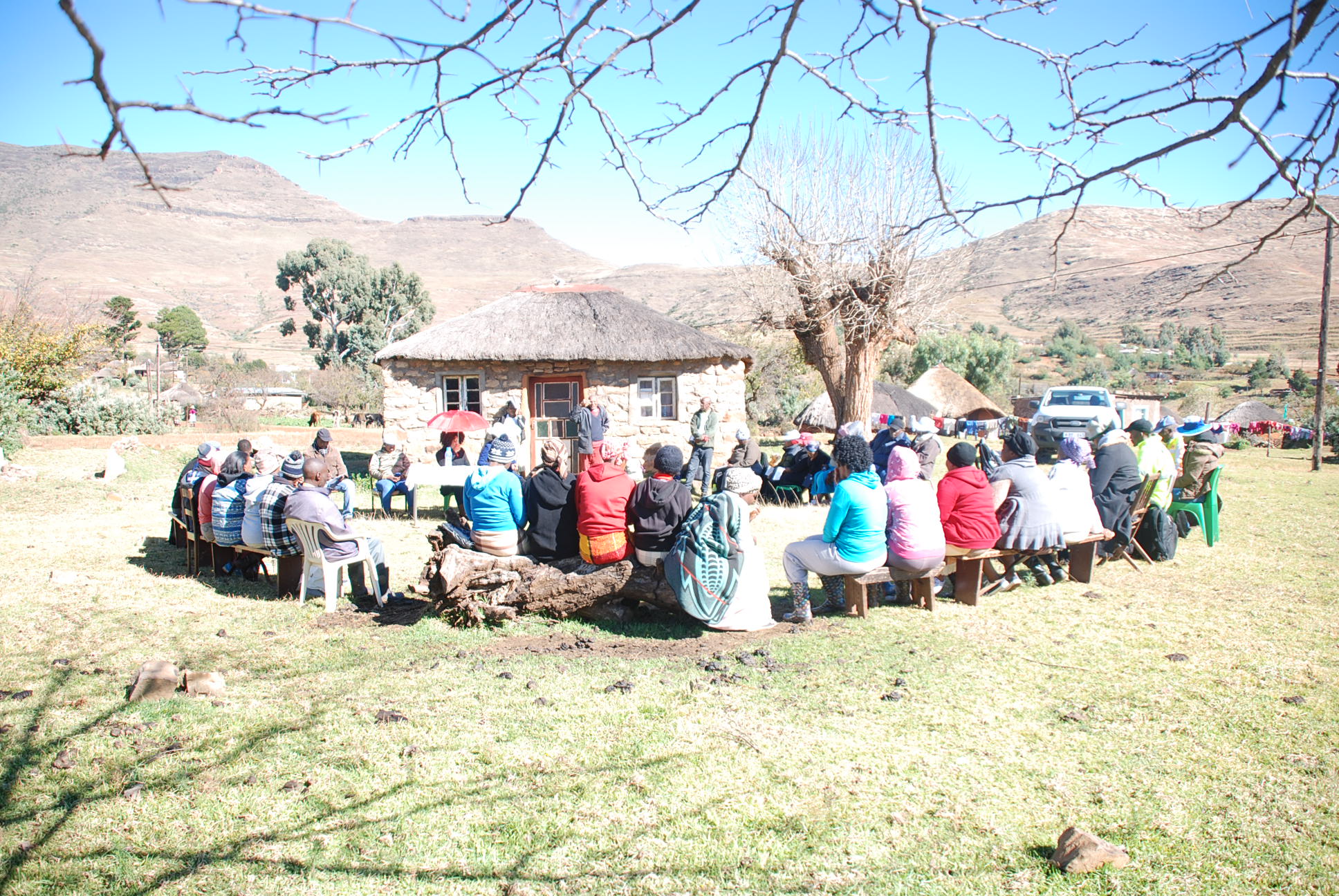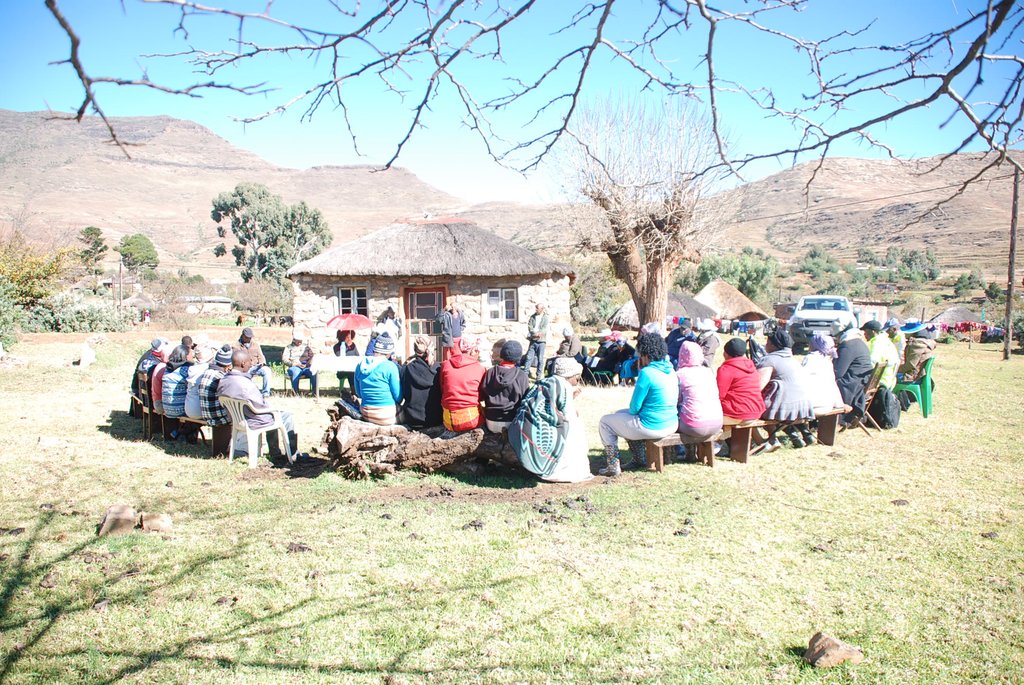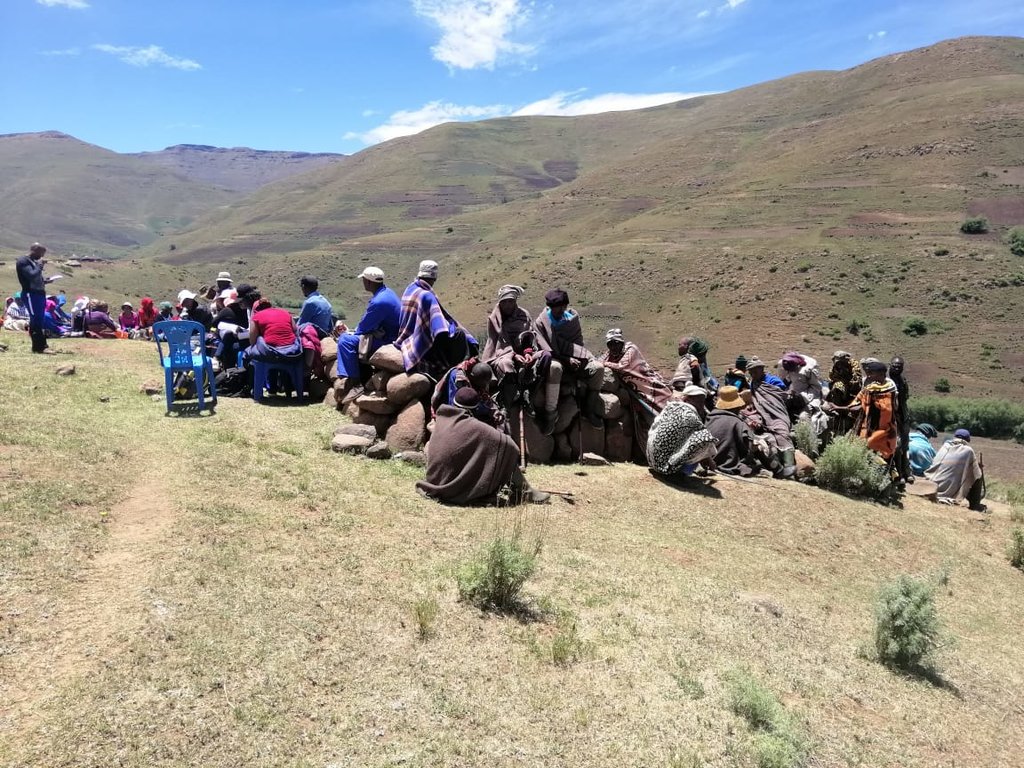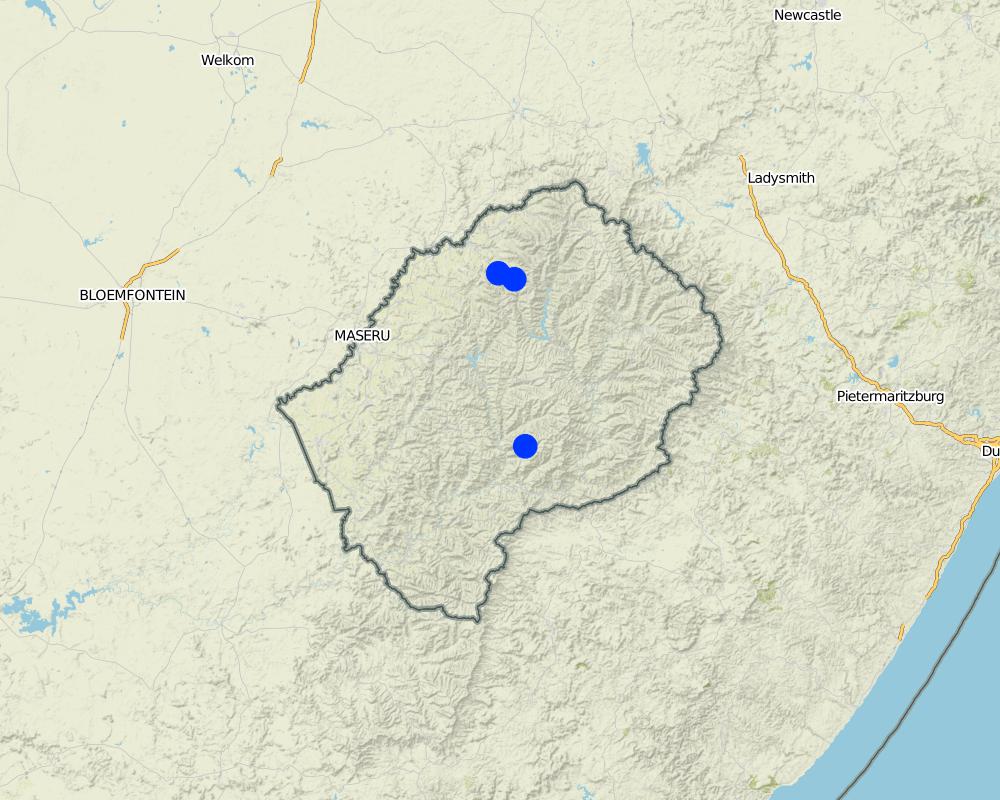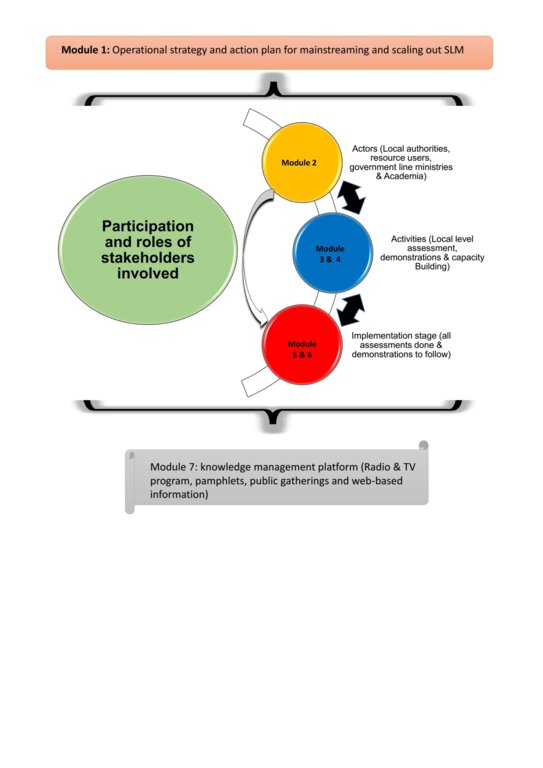Focus Group Discussion [Lesotho]
- Creation:
- Update:
- Compiler: Matoka Moshoeshoe
- Editor: –
- Reviewers: Rima Mekdaschi Studer, William Critchley
Pitso
approaches_4266 - Lesotho
View sections
Expand all Collapse all1. General information
1.2 Contact details of resource persons and institutions involved in the assessment and documentation of the Approach
Name of project which facilitated the documentation/ evaluation of the Approach (if relevant)
Decision Support for Mainstreaming and Scaling out Sustainable Land Management (GEF-FAO / DS-SLM)Name of the institution(s) which facilitated the documentation/ evaluation of the Approach (if relevant)
Integrated Catchment Management Project (Integrated Catchment Management Project) - Lesotho1.3 Conditions regarding the use of data documented through WOCAT
When were the data compiled (in the field)?
27/05/2018
The compiler and key resource person(s) accept the conditions regarding the use of data documented through WOCAT:
Yes
1.4 Reference(s) to Questionnaire(s) on SLM Technologies
2. Description of the SLM Approach
2.1 Short description of the Approach
This focus group discussion was composed of 15-20 participants: community elders, youth, (males and females as informed by local beliefs and norms), retired government officials.The aim of community focus group discussion was to find land users’perception and behaviour on land uses and SLM. It was organised by Ministry of Forestry, LADA coordinator and national consultant. The target group was land users, local authorities, youth, small stock owners, retired government officials. The target group mandate was also to draw the community map which also showed the land uses and resources. This focus group discussion gave researchers information on land uses, natural resources, prior SLM interventions, and many more.
2.2 Detailed description of the Approach
Detailed description of the Approach:
1. Conducted an initial field visit before the focus group discussion (FGD) with the selected villages within the sub-catchment: A tour by road with a few key informants to familiarise officers with the study area, land uses, also the extent and severity of degradation and types and extent of conservation and improved land management measures with the result being a community territorial map.
2. The aim of Focus Group Discussion (FGD) is to obtain information about range of land-users, their individual and communal management regime and the history of their area. This method is used as the first stage of implementation in LADA local level assessment.
3. The FGD representatives consisted of different social groups (i.e. both men and women – and different age groups) between 15-20 members. These members together with technocrats sat at round table set up which enabled free and interactive communication and feedback.
Each study area had its own list of FGD questions and facilitated them accordingly. Field Assessments confining; six (6) study areas in each sub-catchment.
•Vegetation assessment.
•Soil assessments which entail soil erosion and soil properties (2 study areas).
•Water resources assessment with key informant interviews on water resources.
•Household livelihood assessments.
•Land use systems
4. The target group mandate was also to draw the community map which also showed the land uses and resources. This focus group discussion gave researchers information on land uses, natural resources, prior SLM interventions, and many more. This approach enabled land users to present all their views without fear or dominance by other members. They realised that they have their resources in abundance, however, they need to improve their status as their livelihoods entirely depends on their good use.
5. It was organised by Ministry of Forestry, National University of Lesotho, Ministry of Agriculture, Ministry of Water, Ministry of Local Government,LADA coordinator and national consultant. The target group was land users, local authorities, youth, small stock owners, retired government officials.
6. The advantage of FGD was that the land users were taught on income generating activities such as orchard establishment, food processing, vegetable production under shade nets/tunnels (climate smart agriculture). They did not like the timing of FGD because it interfered with their haresting season, it took longer than it was intended and the weather conditions were not condusive as it was too cold and on the second day, snow began to fall.
2.3 Photos of the Approach
2.4 Videos of the Approach
Comments, short description:
No videos taken
Date:
13/12/2018
Location:
Maseru
Name of videographer:
N/A
2.5 Country/ region/ locations where the Approach has been applied
Country:
Lesotho
Region/ State/ Province:
Southern Africa
Further specification of location:
Focus group discussions were held in three different catchments (Ha Mahloane, Bolahla Pitseng in Leribe district, Lesobeng khutlo se-metsi catchment in Thaba-Tseka district and Ha mosuoe catchment in Quthing district.
Comments:
Bolahla-Mphosong catchment
Map
×2.6 Dates of initiation and termination of the Approach
If precise year is not known, indicate approximate date when the Approach was initiated:
10-50 years ago
Year of termination (if Approach is no longer applied):
2030
Comments:
On-going
2.7 Type of Approach
- project/ programme based
2.8 Main aims/ objectives of the Approach
To find land-users views on their status of their natural resources and if they have indigenous knowledge systems applicable to be used in the management method
2.9 Conditions enabling or hindering implementation of the Technology/ Technologies applied under the Approach
social/ cultural/ religious norms and values
- enabling
socio-economic factors can hinder the application of this technology
availability/ access to financial resources and services
- enabling
FAOLS country office assisted with finances
institutional setting
- enabling
The Lesotho government has provided all conditions necessary
collaboration/ coordination of actors
- enabling
Other line ministries have fully participated
legal framework (land tenure, land and water use rights)
- hindering
Lesotho land tenure needs to be reviewed
policies
- hindering
The Department of Soil and Water Conservation's policy is still in its draft form.
land governance (decision-making, implementation and enforcement)
- hindering
In Lesotho, land is communally owned
knowledge about SLM, access to technical support
- enabling
Farmer-Extension worker ratio is too high to enable adequate scaling up of SLM technologies
markets (to purchase inputs, sell products) and prices
- hindering
limited subsidies towards direct sourcing of specific inputs
workload, availability of manpower
- hindering
Farmer-Extension worker ratio is too high to enable adequate scaling up of SLM technologies
3. Participation and roles of stakeholders involved
3.1 Stakeholders involved in the Approach and their roles
- local land users/ local communities
farmers, traditional healers
participants
- SLM specialists/ agricultural advisers
soil scientists, agriculturalists, environmentalists and hydrologists
facilitators
- researchers
National University of Lesotho (natural resource management researchers)
facilitators/reseachers
- local government
Chiefs and Local councillors
community organisers
- national government (planners, decision-makers)
Soil and Water resource line ministries
planning, mentoring and decision support
If several stakeholders were involved, indicate lead agency:
Ministry of Forestry, Range and Soil Conservation
3.2 Involvement of local land users/ local communities in the different phases of the Approach
| Involvement of local land users/ local communities | Specify who was involved and describe activities | |
|---|---|---|
| initiation/ motivation | interactive | key informants as community representatives |
| planning | interactive | key informants and technocrats working together to produce community maps |
| implementation | interactive | technocrats tour guided by community elders |
| monitoring/ evaluation | none | |
| none |
3.3 Flow chart (if available)
Description:
This flow chart describes participation of stakeholders in the implementation of DS-SLM activities in Lesotho
Author:
Koetlisi Koetlisi (PhD) and Matoka Moshoeshoe
3.4 Decision-making on the selection of SLM Technology/ Technologies
Specify who decided on the selection of the Technology/ Technologies to be implemented:
- mainly SLM specialists, following consultation with land users
Explain:
Technocrats recommend SLM activities to land-users who in turn adopt the suggested technologies attributed to their impact land-users' livelihoods
Specify on what basis decisions were made:
- evaluation of well-documented SLM knowledge (evidence-based decision-making)
4. Technical support, capacity building, and knowledge management
4.1 Capacity building/ training
Was training provided to land users/ other stakeholders?
No
4.2 Advisory service
Do land users have access to an advisory service?
Yes
Specify whether advisory service is provided:
- on land users' fields
- at permanent centres
Describe/ comments:
There are farmer-farmer visits facilitated by extension workers. There are also agriculture resource centres whereby farmers visit to get more information.
4.3 Institution strengthening (organizational development)
Have institutions been established or strengthened through the Approach?
- no
4.4 Monitoring and evaluation
Is monitoring and evaluation part of the Approach?
No
4.5 Research
Was research part of the Approach?
Yes
Specify topics:
- sociology
- economics / marketing
- ecology
Give further details and indicate who did the research:
Each researcher facilitated their area of speciality and this enabled the question-answer session to be easy. community members had bottle-necks which researchers ironed. The challenge in extension services is means of transport to the landusers due to terrain of our country, so extension service is somehow compromised and not acessible at all times.
5. Financing and external material support
5.1 Annual budget for the SLM component of the Approach
If precise annual budget is not known, indicate range:
- 2,000-10,000
Comments (e.g. main sources of funding/ major donors):
FAO-UN
Government of Lesotho
The money caters for accomodation, meals, transport, refreshments for researchers. This is because reseachers do not reside where the FGD was taking place, after the FGD followed LADA local level assessment, which was conducted for 15 days.
5.2 Financial/ material support provided to land users
Did land users receive financial/ material support for implementing the Technology/ Technologies?
No
5.3 Subsidies for specific inputs (including labour)
- none
Comments:
N/A
5.4 Credit
Was credit provided under the Approach for SLM activities?
No
5.5 Other incentives or instruments
Were other incentives or instruments used to promote implementation of SLM Technologies?
Yes
If yes, specify:
There are policies and laws which were referred to in order to support SLM such as Forest Act (1998), Range Resources Management policy (2013)
6. Impact analysis and concluding statements
6.1 Impacts of the Approach
Did the Approach enable evidence-based decision-making?
- No
- Yes, little
- Yes, moderately
- Yes, greatly
participants exchanged information without any hindrance as they were able to learn based on their baseline knowledge
Did the Approach help land users to implement and maintain SLM Technologies?
- No
- Yes, little
- Yes, moderately
- Yes, greatly
Land users were only given a theory on the importance of SLM technologies not how technologies are constructed. other researchers were novice in land management, it is though this approach where they learned facilitation skills. In Lesotho, land management activities are implemented mostly by women, youth and elderly because men in the villages work in South African mines. The picture of FGD also portrays more women than men
Did the Approach improve coordination and cost-effective implementation of SLM?
- No
- Yes, little
- Yes, moderately
- Yes, greatly
This was not part of the agenda
Did the Approach improve knowledge and capacities of land users to implement SLM?
- No
- Yes, little
- Yes, moderately
- Yes, greatly
It was agreed that participants would take part in demonstrations that would be implemented later in their respective communities
Did the Approach improve knowledge and capacities of other stakeholders?
- No
- Yes, little
- Yes, moderately
- Yes, greatly
All stakeholders in the natural resources management had a chance to discuss collectively- not in silos, issues that concerned them
Did the Approach build/ strengthen institutions, collaboration between stakeholders?
- No
- Yes, little
- Yes, moderately
- Yes, greatly
All stakeholders in the natural resources management had a chance to discuss collectively- not in silos, issues that concerned them. Presence of researchers strengthened this collaboration.
Did the Approach empower socially and economically disadvantaged groups?
- No
- Yes, little
- Yes, moderately
- Yes, greatly
Did the Approach improve gender equality and empower women and girls?
- No
- Yes, little
- Yes, moderately
- Yes, greatly
all levels of society were represented
Did the Approach encourage young people/ the next generation of land users to engage in SLM?
- No
- Yes, little
- Yes, moderately
- Yes, greatly
The youth were also represented
Did the Approach improve issues of land tenure/ user rights that hindered implementation of SLM Technologies?
- No
- Yes, little
- Yes, moderately
- Yes, greatly
Lesotho land tenure issues need to be addressed at national level
Did the Approach lead to improved food security/ improved nutrition?
- No
- Yes, little
- Yes, moderately
- Yes, greatly
Officers from Ministry of Agriculture through extension, delivered issues of nutrition and food security
Did the Approach improve access to markets?
- No
- Yes, little
- Yes, moderately
- Yes, greatly
There is abundance of natural resources in this area. Members were made aware of markets opportunities around them
Did the Approach lead to improved access to water and sanitation?
- No
- Yes, little
- Yes, moderately
- Yes, greatly
Officers from Ministry of Water advised on issues of water and sanitation
Did the Approach lead to more sustainable use/ sources of energy?
- No
- Yes, little
- Yes, moderately
- Yes, greatly
The community entirely depends on the natural resources for better livelihoods
Did the Approach improve the capacity of the land users to adapt to climate changes/ extremes and mitigate climate related disasters?
- No
- Yes, little
- Yes, moderately
- Yes, greatly
Climate change issues were also discussed and participants were made aware of the effects.
Did the Approach lead to employment, income opportunities?
- No
- Yes, little
- Yes, moderately
- Yes, greatly
Key informants were asked about their means of livelihoods in the area. This opened income opportunities to some members
6.2 Main motivation of land users to implement SLM
- increased production
Land productivity has been declining attributed to land degradation. SLM is seen as the only measure to help farmers in increasing their production
- reduced land degradation
Lesotho's landscape is severely eroded. Land users would like use SLM as an approach to halt land degradation
6.3 Sustainability of Approach activities
Can the land users sustain what has been implemented through the Approach (without external support)?
- uncertain
If no or uncertain, specify and comment:
Without external support, farmers are not able to implement activities fully
6.4 Strengths/ advantages of the Approach
| Strengths/ advantages/ opportunities in the land user’s view |
|---|
| Knowledge management |
| It can easily be implemented |
| It brings different land user groups together |
| Strengths/ advantages/ opportunities in the compiler’s or other key resource person’s view |
|---|
| other key resource persons such as local authorities liked this approach because it them ideas on which resources are available in the catchment and how communities utilise them for survival. The land users on the other hand ound this approach very useful as they were empowered and allowed to say their views without fear or favor as they were informed that there were no wrong answers. everybody participated fully |
6.5 Weaknesses/ disadvantages of the Approach and ways of overcoming them
| Weaknesses/ disadvantages/ risks in the land user’s view | How can they be overcome? |
|---|---|
| It is limited to key informants | It should be replicated within the same community but, with different participants (Key) |
| Some key informants tend to dominate the discussion | The facilitator should be observant and try to control dominating participants |
| It may become a platform for conflicts | Local authorities should be present in case conflicts arise |
7. References and links
7.1 Methods/ sources of information
- field visits, field surveys
15-25 informants, these are representatives of each village whereby each village was represented by 2/3 participants. these are the people who formed FGD
- interviews with land users
10% of total households per catchment
7.2 References to available publications
Title, author, year, ISBN:
N/A
7.3 Links to relevant information which is available online
Title/ description:
Ministry of Forestry, Range and Soil Conservation
URL:
https://forestry.gov.ls
Title/ description:
Lesotho Soil Information System
URL:
https://lesis.gov.ls
Links and modules
Expand all Collapse allLinks
No links
Modules
No modules


